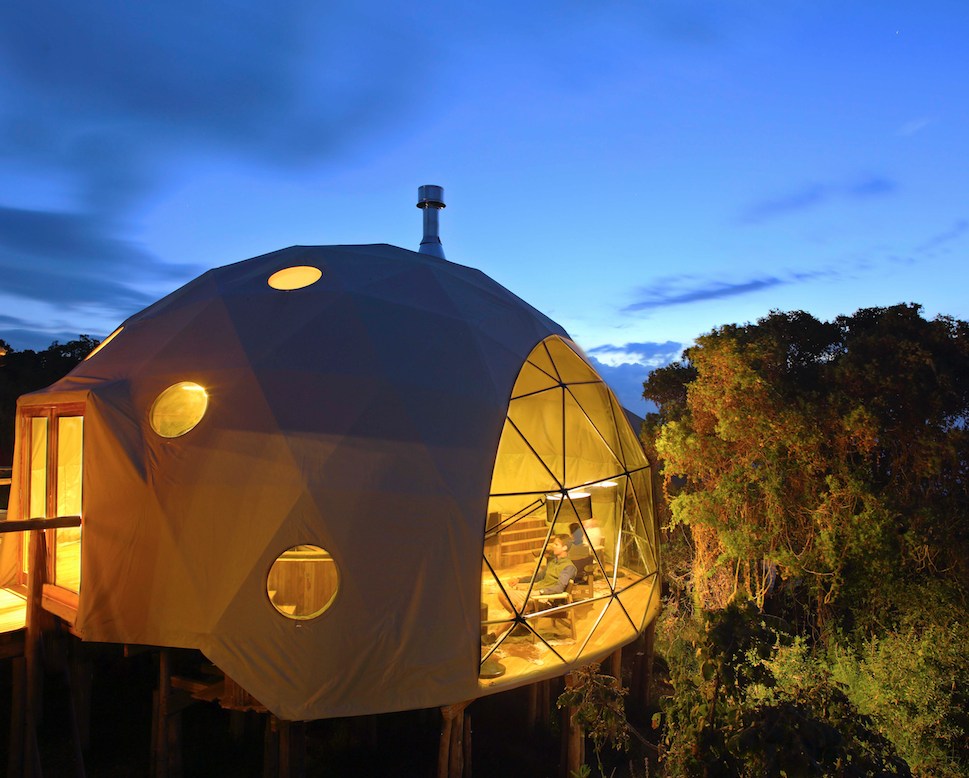
Being at one with nature usually entails eschewing home comforts, but visitors to Tanzania can have a wild old time of it while living in luxury, writes Matthew Hardeman
Those in the know will tell you a trip to Tanzania is best done in two parts, or at least it’s the norm these days: the barefoot bliss of Zanzibar and its environs in the tropical south (or even a trip to your own private island such as Thanda, in the Indian Ocean), then a short hop on a Cessna or two from the natural wonders of the Ngorongoro Highlands and its famous crater, home to the highest concentration of wildlife in Africa, and one of the planet’s most breathtaking vistas.
Visitors to the latter have, for years, frequented well-known camps such as Crater Lodge, but now there’s a new (and rather more novel) way to experience the Highlands without the more kitschy colonial vibes. A few hours’ drive from Lake Manyara’s red earth airstrip through small towns and villages and along the bumpy dirt roads of the Ngorongoro Conservation Area, you’ll find Asilia Africa’s Highlands camp.
Aiming to create a harmonious blend of luxury, authenticity and ecology, Asilia is the brainchild of its founders, Dutch entrepreneurs Bas Hochstenbach and Jeroen Harderwijk. The former bankers and consultants set their sights on the Ngorongoro in 2013 to offer ‘a perfect balance between a true wilderness experience and a high-style, contemporary escape’, adding to their existing collection of nineteen camps 09across Tanzania and Kenya.
Opening (or rather, unzipping) its tent doors to guests in August 2016, the camp’s aesthetic is striking. Greeted by cheerful Maasai guides in traditional chequered garb offering cold drinks and frozen towels on arrival, guests are led to one of eight large canvas geodesic dome-shaped suites with tastefully furnished Boho-chic interiors. Each one features comfortable king-size beds, ensuite bathrooms with his-and-hers showers (there’s hot running water and flushing toilets, which are not to be taken for granted in these parts), and wood-burning fireplaces to keep warm at night. Panoramic bay windows provide sprawling views, east and west, and spectacular sunset and sunrise views of Empakaai and the Gol Mountains from the suites. The landscape is evocative of Scotland (hence the Highlands moniker), or the American West on steroids. You’re experiencing the Africa that Hemingway wrote about, only in rather more comfort.
As with any boho bush camp that seeks respect, sustainability is high on the agenda. Permanent structures are not allowed in the Ngorongoro Conservation Area, meaning camps such as Asilia must be able to tear everything down without a trace — there’s no concrete anywhere, which is especially pleasing for urban jungle dwellers. The fact that few rivals have had the wherewithal to meet the park’s stringent requirements means the camp can occupy the location it does by itself. The others are located on the other, much more crowded side of the park, nearer the Ngorongoro crater. Add that to the scarce connectivity with the outside world (wi-fi is limited — and that’s no bad thing) and the result is a sense of solace and remoteness you would be hard pressed to find anywhere else.
Based on designs by American architect Buckminster Fuller, the domes that dominate the camp resemble large beehives. You’ll certainly come across a few real bees feasting on the wilderness wildflowers popping up from the dense green brush, interspersed by wooden walkways and grassy paths that lead to each tent. With the domes spread out for maximum privacy, your only company will be the colourful birds flitting from tree to tree.
For all the camp’s luxury, you don’t want to miss the natural wonders you came here for: led by the camp’s expert local guides, guests can climb the ancient Maasai trails to the Olmoti crater’s edge directly from the camp, and the stunning, cloud-swallowing crater of Empakaai is just a short drive away. To peer over the edge of the Ngorongoro crater (or caldera, as it’s technically known) is to gaze upon the highest concentration of big game anywhere in Africa — 25,000 at peak season — while venturing down into its heart is an unforgettable experience. You won’t be short of human company these days, with a number of other vehicles usually present at any one time, but with the array of wildlife you’ll see here, it is still spectacular. You may not be assured of spotting everything that lives there, given the park’s size — but you are guaranteed to witness most of them, in droves: elephant and black rhino, zebra and buffalo, baboons, hyenas, hippos, cheetahs, warthogs, and flamingos.
Down by the river, our guides prepared lunch not a moment too soon, setting up an immaculate spread in what is surely one of the most novel and exciting dining spots on earth. The thought that lions were roaming free in the background did not concern us.
After the early morning start and day’s safari have sapped your energy, you can retire to the bar in the cosy shared living area that doubles as the camp’s lobby. Sit by a fire, chat and play board games with an ice-cold gin and tonic as you wait for dinner in the communal dining dome. Typically you will feast on local chicken and fish dishes, beautifully presented in the local style with local ingredients.
For all the comforts on hand, there’s no forgetting where you are. You’ll have to rely on a two-way radio system (all guests get a walkie-talkie) to call for one of the Maasai guides to escort you at night — this is mandatory because of the fearsome buffalo’s fondness for wandering through the camp on occasion. There are baboons too, and hyenas — neither of which you are likely to enjoy running into on your own — but little else will give you a sense of place quite like hearing their unmistakable howling across the valley, under a full moon.
Knowing where you are, be prepared to take the initiative yourself on occasion. The staff — almost exclusively local Maasai — may not have heard of your favourite cocktail or fully understand your most bizarre request, but they have hearts of
gold and will do their best to help. It also gets seriously cold here. The camp sits on a volcanic gradient and temperatures can easily reach freezing at night, so pack warm for the nights, and cool for the day.
Getting up at dawn to cross the plains under the early morning sun, it’s hard not to be moved: fluffy clouds hang low across the valley, blanketing the villages pierced only by the tips of the straw bomas and clusters of free-roaming zebra.
It’s a scene one could imagine as a fantastical medieval village in the clouds, rather than anything you might consider lifelike. Here, you can visit the locals for a rare insight into the traditional Maasai way of life that has dominated this part of East Africa for hundreds of years, and if you are lucky, and arrive on the correct day, you will catch a glimpse of their ancient rituals and dances. The sense of peace instilled by their gentle warmth and the vast, rolling landscape is indelible — and it’s central to the vibe of the Highlands. Whether it’s the beaming smiles of the village children, awe-inspiring encounters with big game, ethereal high-altitude vistas or unspoilt views of the Milky Way, when you hear people talking about the ‘God continent’ or a feeling of ‘coming home’ to Africa, this is what they are talking about.
Matthew Hardeman is deputy head of the Spear’s Research Unit








